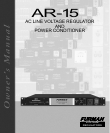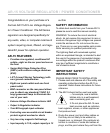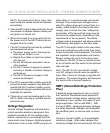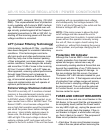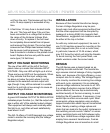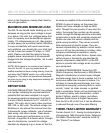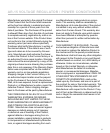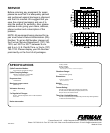
AR-15 VOLTAGE REGULATOR / POWER CONDITIONER
errors in line frequency, making them ideal for
use with generators.
MAXIMUM AND MINIMUM LOAD
The AR-15 can handle loads totalling up to 15
amperes as long as the input voltage is equal
to or above 124 volts. For voltages below that
level, its capacity must be derated at approxi-
mately 113 milliamperes per volt. (See graphs
on back page.) As a practical matter, therefore,
to cope successfully with worst-case brown-
out conditions, you should plan your total load
so that it does not exceed 12 amps, or 1400
watts. Please note that this refers to the ag-
gregate power requirement of all equipment
plugged into the Voltage Regulator, not to each
individual item.
NOTE: While there is no minimum load require-
ment for the AR-15 you may experience an
audible mechanical hum coming directly from the
unit when the POWER switch is on with nothing
plugged in. This effect will sometimes disappear
as soon as you plug in any equipment drawing 40
to 50 watts total.
DEFINITIONS
VOLTAGE REGULATION: The AC line voltage
is a number indicating the nominal electrical
potential that has been adopted in a region
for powering electrical equipment of all kinds.
In most of North America it is 117 volts AC; in
Japan, 100 volts; and in many other countries
220, 230, or 240 volts. The actual voltage can
fall below or rise above this nominal level due
to brownouts, power cutbacks, use of substan-
dard wiring, and other causes. These devia-
tions can cause poor performance or a mal-
function. A regulator is a device which, through
use of a transformer, corrects the voltage
deviation by stepping it up or down so that it is
as close as possible to the nominal level.
SPIKE: A pulse of energy on the power line.
Spikes can have voltages as high as 6000
volts. Though they are usually of very short du-
ration, the energy they contain can be consid-
erable, enough to damage sensitive solid-state
components in audio and computer equipment.
Spikes can also foul switch contacts and de-
grade wiring insulation. They are an unavoid-
able component of electric power. They are
caused unpredictably by electric motors switch-
ing on or off (on the premises or outside), utility
company maintenance operations, nearby
lightning strikes, and other factors. Spikes (also
called surges or transients) are absorbed by
special components called MOV’s in the AR-
series to provide safe voltage levels to protect
your equipment.
RFI/EMI INTERFERENCE: Noise from RFI
(Radio Frequency Interference) or EMI (Electro
Magnetic Interference) involves lower voltages
and less energy than is found in spikes, but it is
continuous rather than transient in nature. It is
not likely to cause physical damage, but it can
certainly be annoying, producing static in audio
circuits, “snow” on video screens, or garbled
data in computers. Noise can be introduced into
AC lines by nearby radio transmitters, certain
kinds of lighting, electric motors, and others.
Because noise occurs at higher frequencies
than the 50 or 60 Hz AC line, it can be effective-
ly reduced through use of low-pass ltering.
THREE-YEAR LIMITED WARRANTY
Furman Sound, LLC., having its principal place
of business at 1690 Corporate Circle, Petaluma,
CA 94954 (“Manufacturer”) warrants its AR-15
(the “Product”) as follows:
5



